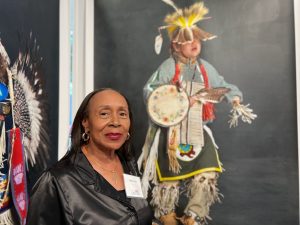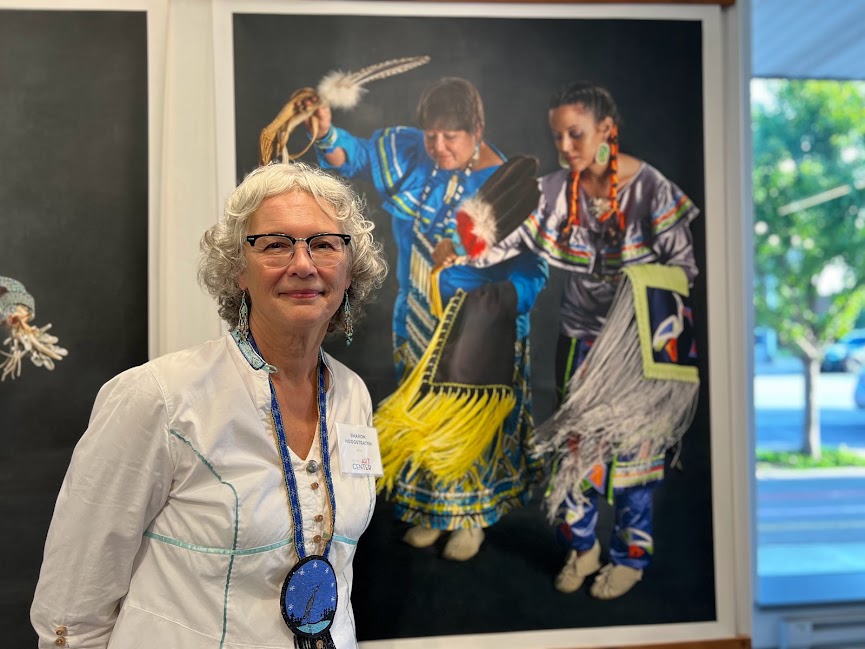Sharon Hoogstraten’s photography exhibit aims to preserve Potawatomi culture
Jack Austin/Daily Senior Staffer
Photographer Sharon Hoogstraten stands in front of one of her works on display at Evanston Art Center.
August 8, 2022
Photography is a vessel for cultural preservation for Sharon Hoogstraten, giving dignity and visibility to a native community that has often been unable to control its own image, she said.
Hoogstraten, a member of the Citizen Potawatomi Nation and a Chicago resident, embarked on a photography project more than 10 years ago, documenting modern Potawatomi people dressed in formal regalia.
Hoogstraten’s high resolution images, the product of a Hasselblad camera, are blown up to life size for display at galleries. “Dancing for our Tribe: Potawatomi Tradition in the New Millenium,” her most recent exhibit, curated by Evanston artist Fran Joy. The exhibit has been on display since July 30, featured an artist talk Friday and runs through Aug. 28th.

About 30 people attended the opening, where Hoogstraten described her photographic process and the journey that led her to document her people.
“I want to preserve a culture, send it to our descendants, (and I want to) let everybody know we’re here,” Hoogstraten said. “Everybody thinks that it’s a disappearing culture. We’ve worked very hard to learn the old art skills to work on preserving language before you lose the elders.”
Wilmette resident Audrey Moy said she was already aware of Hoogstraten’s work, but was especially impressed by the collection on view at the opening. She said she liked the cultural stories Hoogstraten’s photographs tell.
Moy said photographing modern Indigenous life is a way of recognizing a culture that has been marginalized.
“She can capture images that will last through time in our minds,” Moy said. “Again, it tells a story, and talks about where they are going. So we’re able to create that in our hearts and our minds.”
Joy first discovered Hoogstraten’s work at Evanston’s Mitchell Museum of the American Indian. She said she wanted people to feel a sense of the Indigenous culture through the exhibit. Moy and Joy said they believe it is important to recognize Indigenous land.
The large size of the photographs were out of the ordinary, allowing for high resolution, something especially helpful with the ornate and elaborate Indigenous regalia, according to Joy. Additionally, cedar, an important Potawatomi medicinal herb, is used to hang the photos.
“They’re quite large, almost life size, and have a black background to kind of show movements, as if they’re dancing,” Joy said. “And they’re very detailed, and very colorful, rather striking.”
The title of the show and Hoogstraten’s photography book, “Dancing for our Tribe: Potawatomi Tradition in the New Millenium,” reflect the importance of dance in Potawatomi ceremony.
Dance is an essential form of cultural conservation for many Indigenous groups, but Hoogstraten said it is vital for the Potawotami for historical reasons. The Potawatomi signed the most treaties with the U.S. government of any tribe, meaning they were highly mobile and unable to use physical space to hold on to traditions.
“It was really hard for us to hang on to our culture,” Hoogstraten said. “(Many of us were) shipped west of the Mississippi … basically deported. So hanging on to a lot of tradition is not something they take for granted.”
Hoogstraten’s photographs, which are curated in a book set to release in late August, are a way to lay roots down for her kids and her family seven generations forward, she said.
Hoogstraten asks all of her subjects to write a handwritten description of their outfits in terms of the symbolism and what it means to them. Several such explanations were on display in the Evanston gallery.
The exhibit, featured in a small space at the front of the art center, is part of larger long term commitment to diverse artists, and the third of four shows curated by Joy for this year.
At its heart, the display revolves around dignity, pride, and preservation.
“I’m trying to lay down our place on the timeline,” Hoogstraten said. “I am trying to find the roots with my kids.”
Email: [email protected]
Twitter: @JackAustinNews
Related Stories:
— New Evanston Art Center exhibition inspired by cosmos, Black experience
— Block Museum receives large grant to plan exhibit made by Indigenous artists
— Makeba Kedem-DuBose’s colorful works explore race and gender at Evanston Art Center












